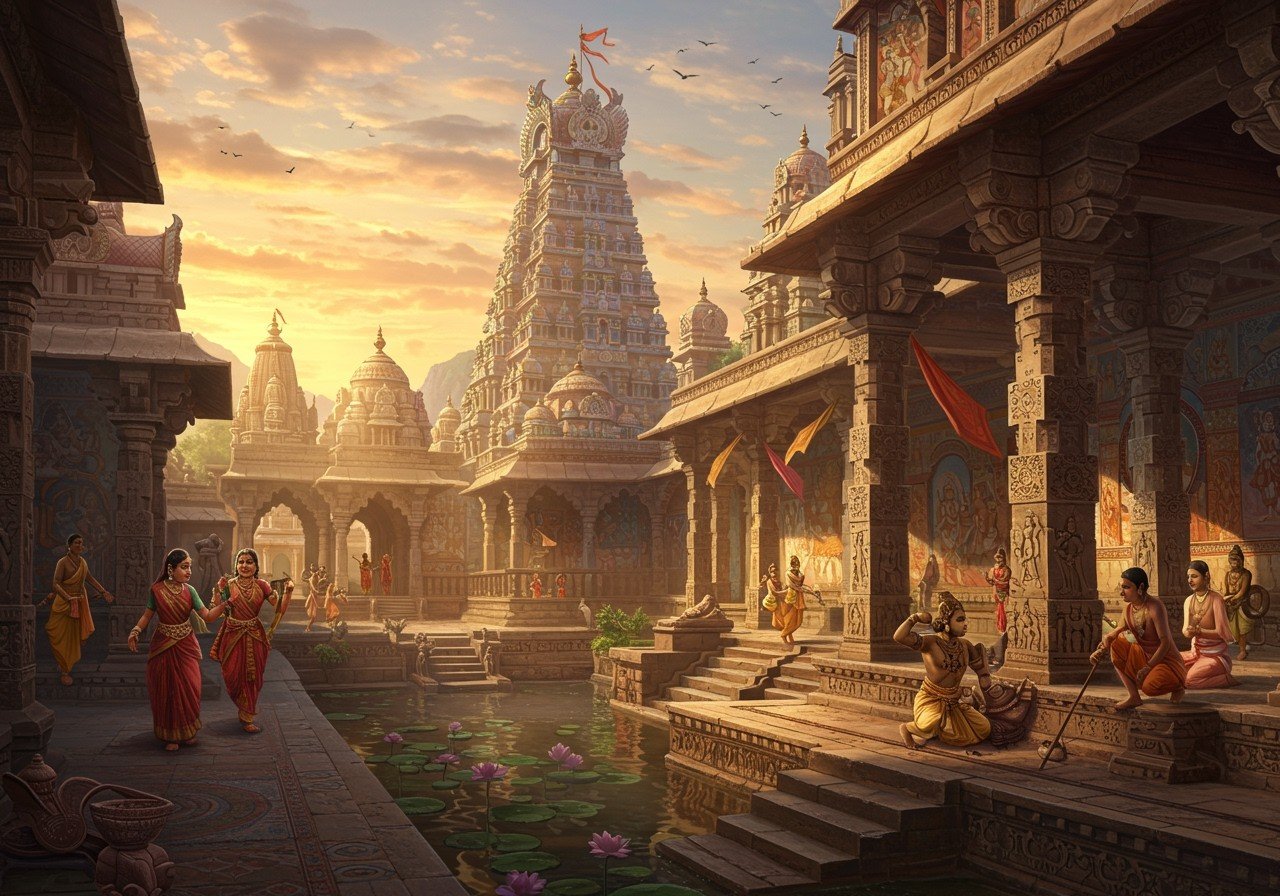
Medieval India, a period spanning from the 6th to the 18th century CE, stands as a testament to a vibrant cultural epoch. This era witnessed the rise and fall of empires, each leaving an indelible mark on India’s artistic, architectural, and cultural landscape. From the majestic temples of the south to the intricate Mughal architecture of the north, this period showcases a breathtaking array of artistic and architectural achievements. For those seeking a deeper understanding of India’s rich heritage, this exploration of medieval Indian art, architecture, and cultural flourishing offers a captivating journey through time.
Architectural Marvels of Medieval India
Medieval India’s architectural landscape is incredibly diverse, showcasing the unique styles and innovations of various dynasties. These structures, built with meticulous detail and grandeur, continue to inspire awe and wonder even today.
- Dravidian Style (6th-18th Century): Flourishing predominantly in South India under dynasties like the Cholas, Pandyas, and Vijayanagara, this style is characterized by towering gopurams (gateways), intricate carvings, and vast temple complexes. Examples include the Brihadeeswarar Temple in Thanjavur and the Meenakshi Amman Temple in Madurai. These temples served as centers of religious and cultural life, showcasing the impressive engineering and artistic skills of the time. Poojn.in offers a range of brass deities reminiscent of those worshipped in these grand temples.
- Indo-Islamic Architecture (12th-18th Century): The arrival of the Delhi Sultanate marked the introduction of Islamic architectural elements into India. This style, a fusion of Islamic, Persian, and Indian influences, is characterized by grand mosques, tombs, and forts featuring domes, minarets, and intricate geometric patterns. Notable examples include the Qutub Minar and the Humayun’s Tomb in Delhi.
- Mughal Architecture (16th-18th Century): The Mughal Empire further refined the Indo-Islamic style, creating opulent structures like the Taj Mahal and Fatehpur Sikri. Mughal architecture is known for its use of marble, elaborate ornamentation, and the integration of gardens and water features into the architectural design. Hinduism’s impact on Indian art and culture also played a significant role during this period.
- Rajputana Style (7th-19th Century): Developed under the Rajput kingdoms of Rajasthan, this style is characterized by majestic forts, opulent palaces, and intricately carved temples. Structures like the Amber Fort and the City Palace in Jaipur exemplify the grandeur and artistic finesse of Rajput architecture. The style showcases a blend of Hindu and Mughal influences, reflecting the region’s rich cultural heritage.
- Vijayanagara Empire Architecture (14th-17th Century): This empire, located in South India, left behind a distinct architectural legacy, exemplified by structures like the Vittala Temple in Hampi. The Vijayanagara style is known for its intricate carvings, ornate pillars, and impressive scale. The Vittala Temple, with its iconic stone chariot and musical pillars, stands as a testament to the empire’s architectural prowess.
Artistic Splendor of Medieval India
Medieval India was a golden age for artistic expression, with various forms flourishing under royal patronage. From intricate stone carvings to vibrant miniature paintings, the art of this period reflects the diverse cultural influences and artistic skills prevalent during this time.
- Stone and Wood Carvings: Temples and palaces across India are adorned with intricate stone and wood carvings depicting mythological scenes, religious figures, and scenes from everyday life. These carvings, often highly detailed and expressive, showcase the skill and artistry of the craftsmen. Poojn.in offers a selection of handcrafted wooden items that echo the artistic traditions of this era.
- Miniature Paintings: This art form flourished under the Mughal and Rajput courts, showcasing detailed depictions of courtly life, historical events, and epic narratives. Known for their vibrant colors, intricate details, and delicate brushwork, miniature paintings offer a glimpse into the cultural and social fabric of the time. The Ramayana’s influence on Indian art is evident in many of these paintings.
- Frescoes and Murals: The walls of temples, caves, and palaces across India are adorned with vibrant frescoes and murals depicting religious stories, folklore, and scenes from courtly life. The Ajanta and Ellora caves, with their stunning murals, stand as prime examples of this art form, preserving stories and traditions for centuries. Explore the vibrant colors of Holi, a festival often depicted in these murals.
Cultural Flourishing in Medieval India
Beyond art and architecture, medieval India witnessed a flourishing of cultural expressions in various forms, including literature, music, and dance. This period saw the emergence of distinct regional cultures, each contributing to the rich tapestry of India’s heritage.
- Literary Traditions: This era witnessed a surge in literary works in regional languages like Tamil, Telugu, Kannada, and Marathi. These literary works, encompassing poetry, prose, and religious texts, offer valuable insights into the social, cultural, and religious values of the time. Celebrate Saraswati Puja, a festival honoring the goddess of knowledge and arts, with Poojn.in.
- Music and Dance: Medieval India saw the development of classical music and dance forms like Bharatanatyam, Kathak, and Hindustani music. These art forms, patronized by royal courts and nurtured within temples, became integral parts of India’s cultural identity. Connect with the divine through Kali Ma devotion, a prominent deity of this period.
- Religious Movements: The Bhakti and Sufi movements played a transformative role in shaping religious and cultural practices during medieval India. These movements emphasized devotion, spiritual equality, and a direct connection with the divine, influencing religious architecture, literature, and music. Discover the spiritual experience of the Sri Sri Kalika Maharani Temple.
Poojn.in: Connecting You to India’s Cultural Heritage
Poojn.in, India’s leading online store for cultural goods and services, offers a wide range of products that connect you with India’s rich heritage. Explore our collection of puja items, religious artifacts, and traditional handicrafts, each carefully curated to reflect the artistic and cultural traditions of medieval India.


